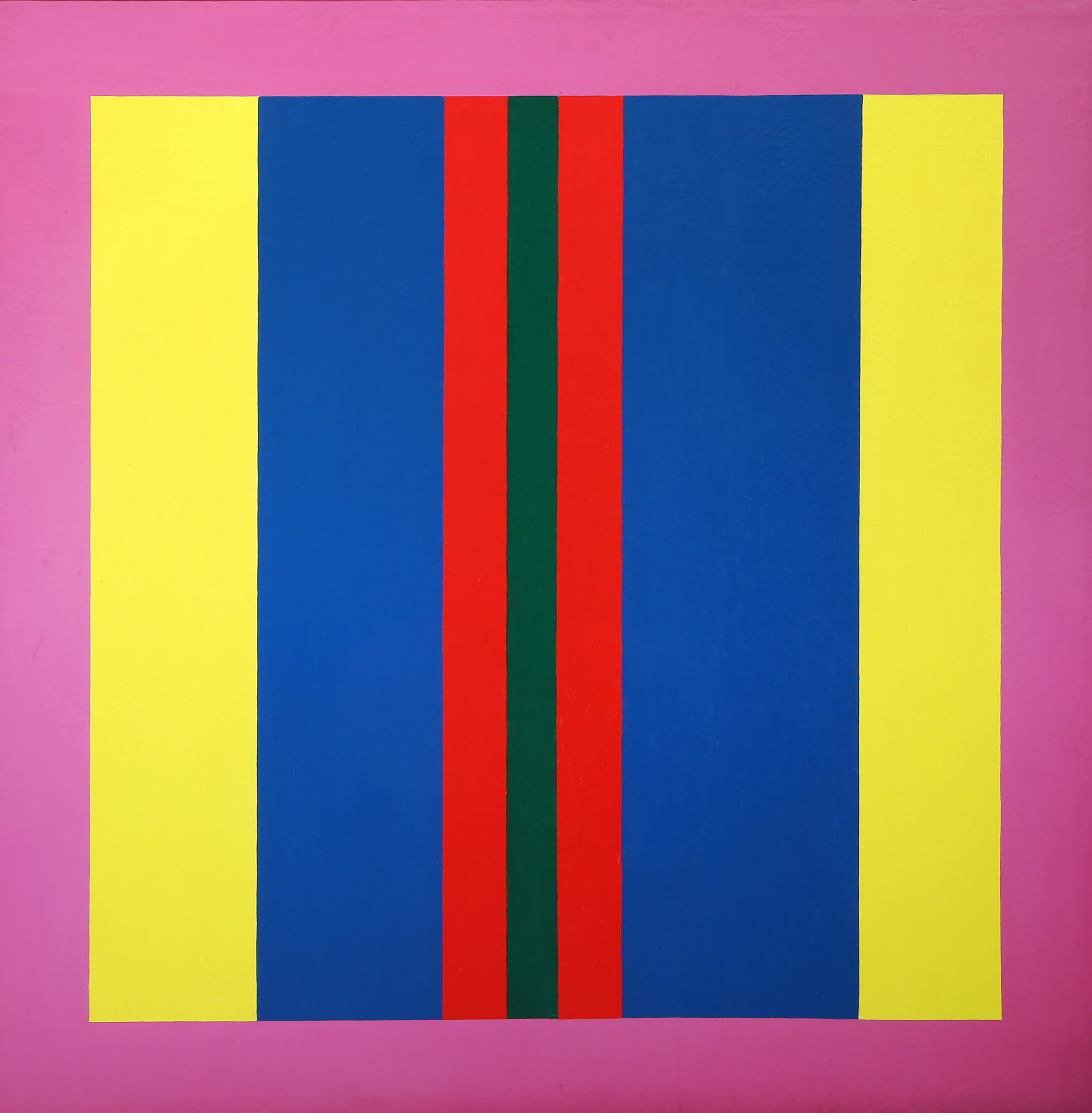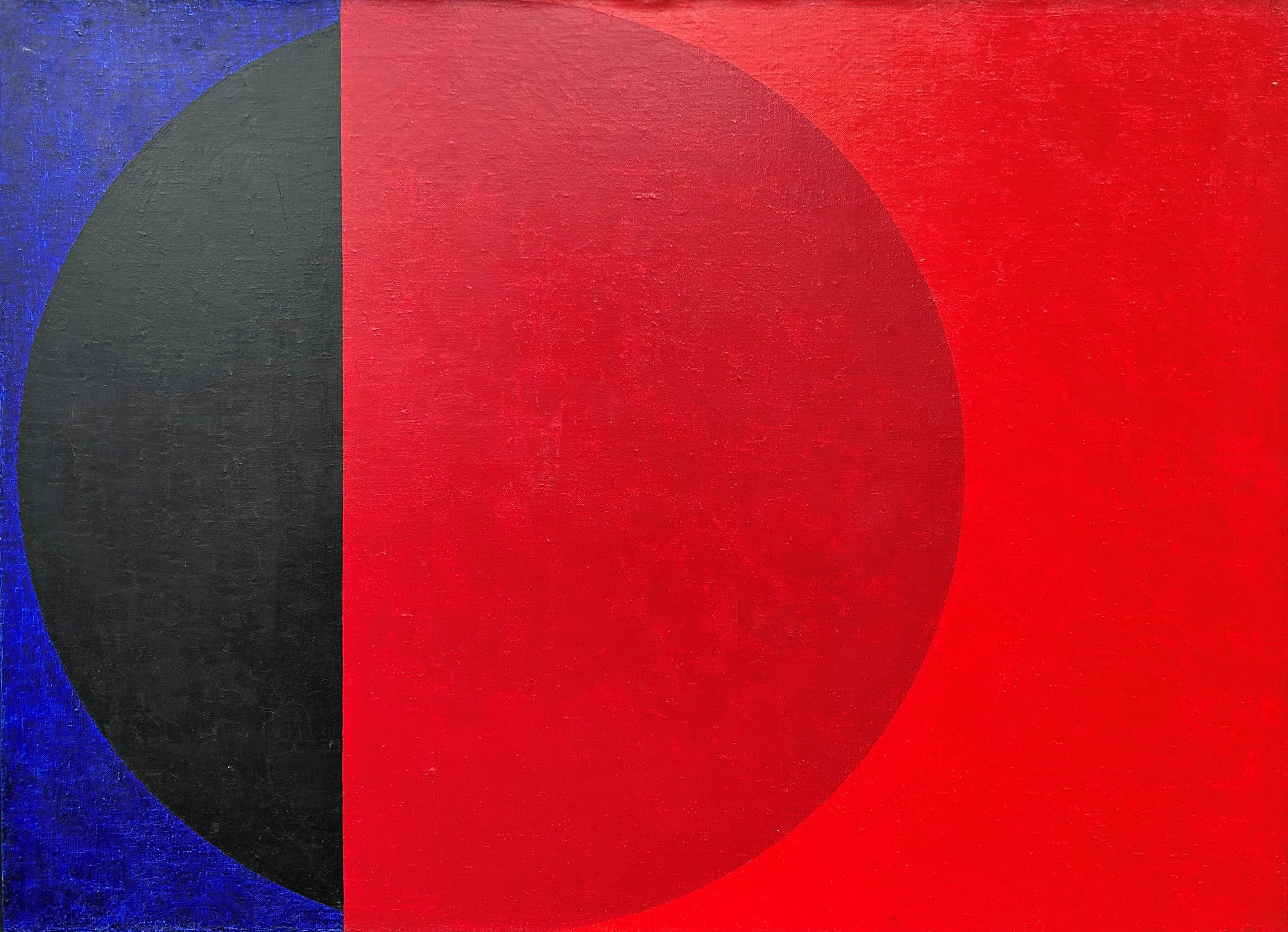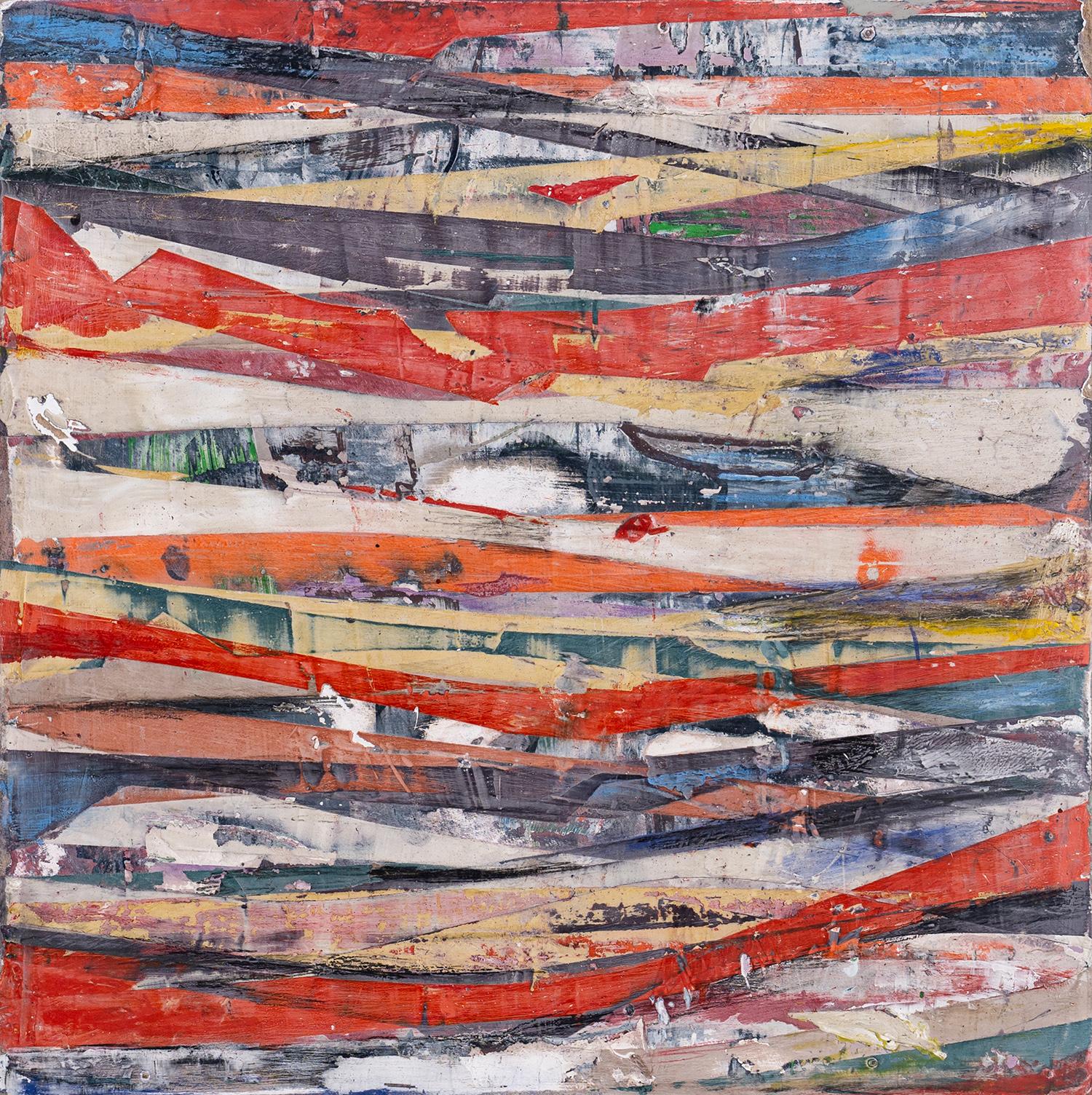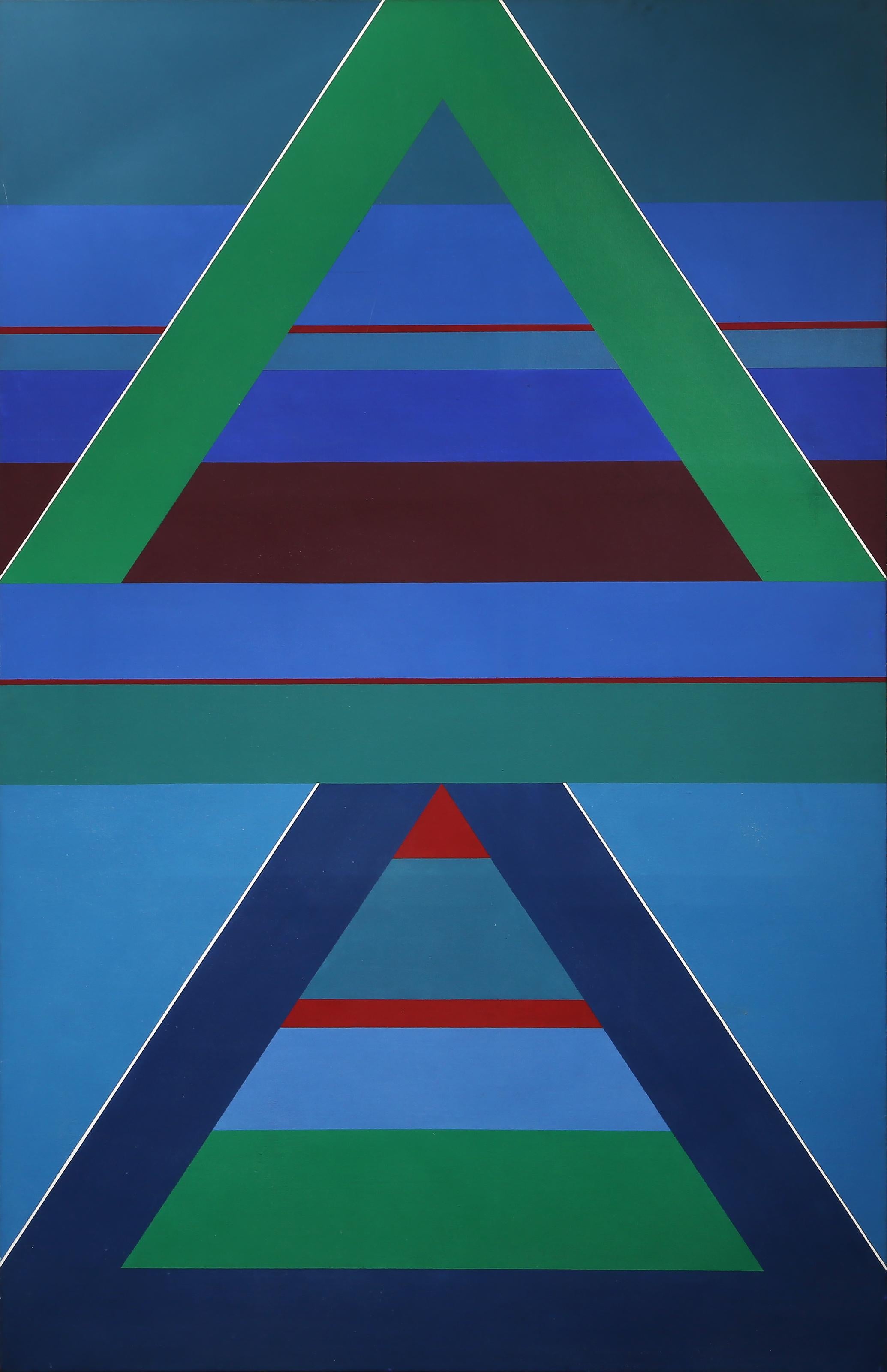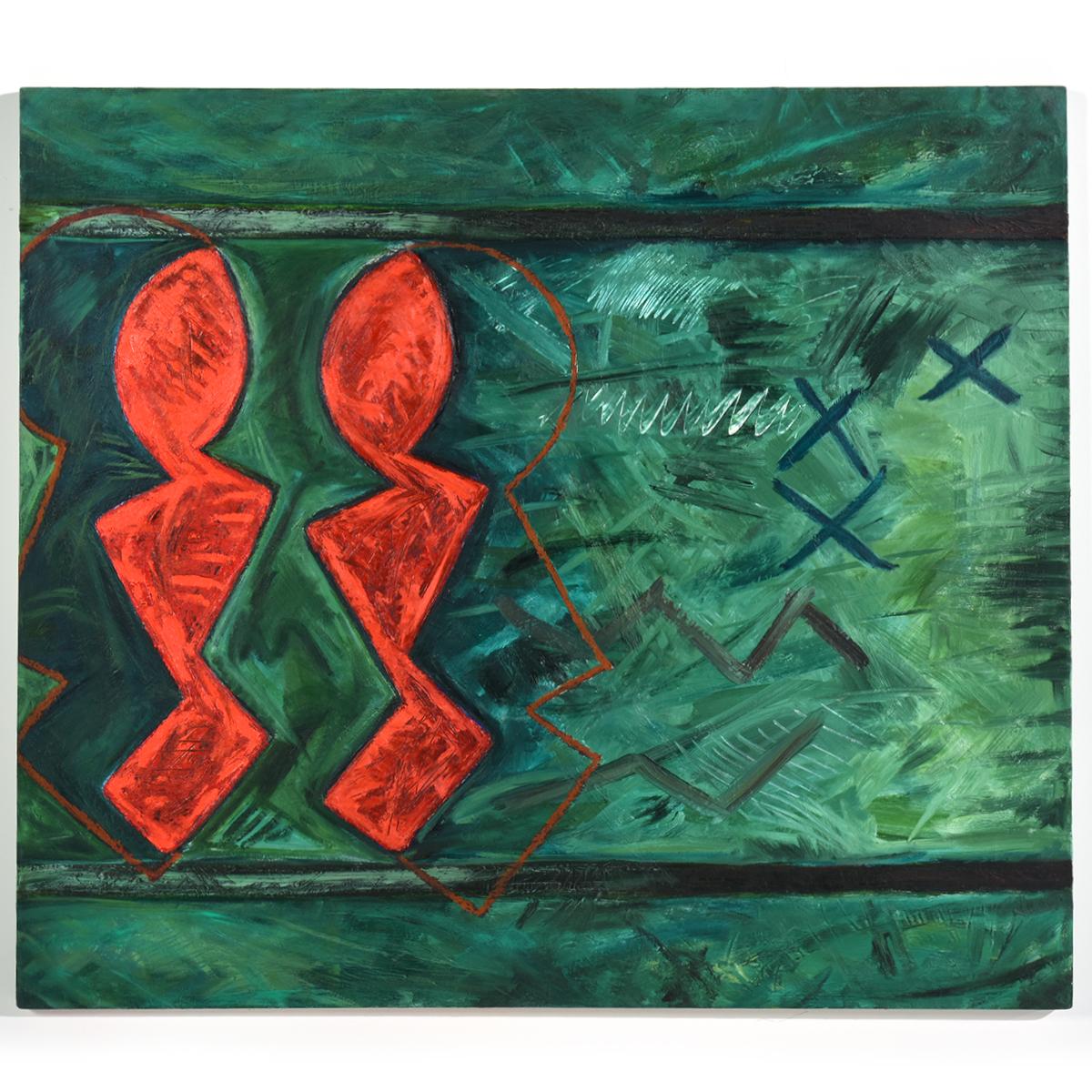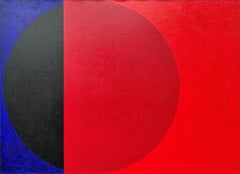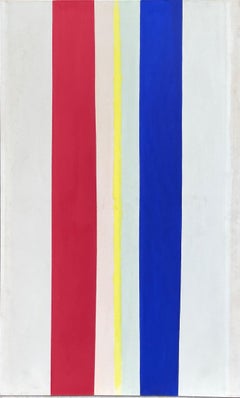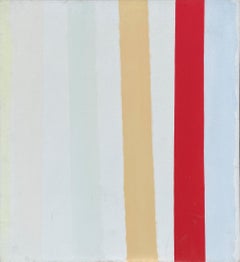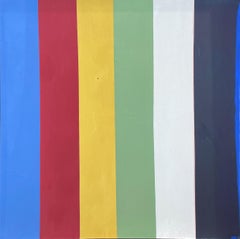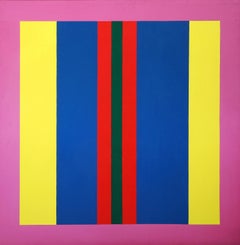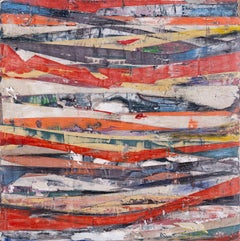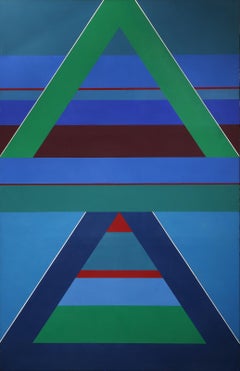Items Similar to "DK. Green, Scarlet, Blue" Oli Sihvonen, Abstract Vertical Geometric Composition
Want more images or videos?
Request additional images or videos from the seller
1 of 7
Oli Sihvonen"DK. Green, Scarlet, Blue" Oli Sihvonen, Abstract Vertical Geometric Composition1977
1977
$15,000
£11,326.39
€13,140.94
CA$21,079.71
A$23,485.78
CHF 12,260.69
MX$285,148.61
NOK 154,108.82
SEK 145,670.27
DKK 98,095.54
About the Item
Oli Sihvonen
DK. Green, Scarlet, Blue, circa 1977
Signed and titled on the reverse
Acrylic on canvas
36 x 36 inches
Known for large, hard-edged abstractions, Oli T. Sihvonen, a Brooklyn native of Finnish ancestry, grew up in Connecticut. He attended the Norwich Art School before enrolling at the Art Students League in New York between 1938 and 1941. During World War II, Sihvonen served in the United States Army as a sergeant, specializing, as he later said, in “camouflage and deception.” His tour of duty took him to Europe where he encountered the work of Paul Cézanne.
In the summer of 1946, Sihvonen traveled to western North Carolina to study at Black Mountain College, which experienced a boost in enrollment following the war years. He was greatly influenced by the progressive color theories of Josef Albers, and, later, the thinking of Buckminster Fuller. After leaving Black Mountain in 1948, Sihvonen continued his studies under the G.I. Bill at Louis Ribak’s Taos Valley Art School in New Mexico from 1949 to 1950. A year spent painting murals in Mexico included work for the Instituto Politécnico Nacional in Mexico City, an early example of his large-scale proficiency. Returning to the East Coast, Sihvonen held a succession of teaching posts: initially in Washington, DC, and then in New York City, first at Hunter College in 1954 and the following academic year at Cooper Union.
Drawn to the southwestern landscape, Sihvonen moved to New Mexico, where he resided in Taos from 1956 through 1967. There, he painted sizeable geometric compositions with exuberant colors, which was atypical of Taos painters. One critic, Paul Goodman, assessed his style with the following description: “Sihvonen’s loving attention to the precise millimeter and the precise hue on the spectrum pays off in a floating and exciting calm and emotion; the picture is in motion, the colors leave their forms and come back changed. The canvas seems to generate its own light, not otherwise than in a bright noonday sun or in mysterious moonlight; there is a fullness of light.” Like Albers, Sihvonen often sought to create a chromatic environment where the brilliance of the colors produces a startling afterimage on the retina.
One of Sihvonen’s favorite shapes was the ellipse, as he considered it “active.” His well-known Ellipse series, represented by Double Matrix on Blue, dates to the 1960s. In geometry, an ellipse is a conic section, or the intersection of a two-dimensional plane and three-dimensional cone. By placing an ellipse within a rectangle, Sihvonen disrupts perception and accentuates the malleability of color.
While his canvases and diptychs received critical praise, Sihvonen once lamented that “dealers are not very interested in showing my work.” One exception was Betty Parsons, a proponent of modern art who accorded Sihvonen a one-man show at her eponymous New York gallery in 1962. Prestigious fellowships from the Yaddo Art Colony along with grants from the National Endowment for the Arts and the Wurlitzer, Pollock-Krasner, and Gottlieb foundations provided much-needed financial support. His work was included in significant exhibitions at the Museum of Modern Art and Whitney Museum of American Art in the late 1960s, and is today represented in these and other prestigious museums’ permanent collections.
- Creator:Oli Sihvonen (1921 - 1991, American, Finnish)
- Creation Year:1977
- Dimensions:Height: 36 in (91.44 cm)Width: 36 in (91.44 cm)
- More Editions & Sizes:Unique WorkPrice: $15,000
- Medium:
- Movement & Style:
- Period:
- Condition:
- Gallery Location:New York, NY
- Reference Number:1stDibs: LU1841215808632
About the Seller
5.0
Platinum Seller
Premium sellers with a 4.7+ rating and 24-hour response times
Established in 2022
1stDibs seller since 2022
120 sales on 1stDibs
Typical response time: <1 hour
- ShippingRetrieving quote...Shipping from: New York, NY
- Return Policy
Authenticity Guarantee
In the unlikely event there’s an issue with an item’s authenticity, contact us within 1 year for a full refund. DetailsMoney-Back Guarantee
If your item is not as described, is damaged in transit, or does not arrive, contact us within 7 days for a full refund. Details24-Hour Cancellation
You have a 24-hour grace period in which to reconsider your purchase, with no questions asked.Vetted Professional Sellers
Our world-class sellers must adhere to strict standards for service and quality, maintaining the integrity of our listings.Price-Match Guarantee
If you find that a seller listed the same item for a lower price elsewhere, we’ll match it.Trusted Global Delivery
Our best-in-class carrier network provides specialized shipping options worldwide, including custom delivery.More From This Seller
View All"The Secrets in the Circle" Oli Sihvonen, Blue and Red Hard-Edge Geometric
Located in New York, NY
Oli T. Sihvonen (1921 - 1991)
The Secrets in the Circle, 1962
Oil on canvas
25 x 34 in
Signed lower right; signed, titled dated, and inscribed "Box 563 Taos, N.M." on the reverse
Pr...
Category
1960s Hard-Edge Abstract Paintings
Materials
Canvas, Oil
"Meridian" Calvert Coggeshall, Abstract Expressionism Hard-edge Vertical Stripes
Located in New York, NY
Calvert Coggeshall
Meridian, 1974
Signed, titled, and dated on the reverse
Acrylic on canvas
67 x 45 inches
Calvert Coggeshall worked as an abstrac...
Category
1970s Abstract Expressionist Abstract Paintings
Materials
Canvas, Acrylic
"A Stripe" Calvert Coggeshall, Abstract Expressionism, Hard-edge Vertical Lines
Located in New York, NY
Calvert Coggeshall
A Stripe, 1971
Signed, titled, and dated on the reverse
Acrylic on canvas
30 x 30 inches
Calvert Coggeshall worked as an abstrac...
Category
1970s Abstract Expressionist Abstract Paintings
Materials
Canvas, Acrylic
"Illumination" Calvert Coggeshall, Abstract Expressionism, Hard-edge Stripes
Located in New York, NY
Calvert Coggeshall
Illumination, 1973
Signed, titled, and dated on the reverse
Acrylic on canvas
65 x 67 inches
Calvert Coggeshall worked as an abs...
Category
1970s Abstract Expressionist Abstract Paintings
Materials
Canvas, Acrylic
"Notes XXI" Calvert Coggeshall, Abstract Expressionism Hardedge Vertical Stripes
Located in New York, NY
Calvert Coggeshall
Notes XXI, 1973
Signed, titled, and dated on the reverse
Japanese pigment on canvas
29 x 29 inches
Calvert Coggeshall worked as ...
Category
1970s Abstract Expressionist Abstract Paintings
Materials
Canvas, Acrylic
"Notes XX" Calvert Coggeshall, Abstract Expressionism Hard-edge Vertical Stripes
Located in New York, NY
Calvert Coggeshall
Notes XX, 1970
Signed, titled, and dated on the reverse
Acrylic on canvas
30 1/4 x 30 1/4 inches
Calvert Coggeshall worked as an...
Category
1970s Abstract Expressionist Abstract Paintings
Materials
Canvas, Acrylic
You May Also Like
No. 2, Hard-Edge Geometric Painting by Dale Laun 1969
Located in Long Island City, NY
Painting No. 2 by Dale Laun, American (1939–2018)
Date: 1968-1969
Acrylic on Canvas
Size: 44 x 46 in. (111.76 x 116.84 cm)
Category
1960s Abstract Geometric Abstract Paintings
Materials
Canvas, Acrylic
$6,500 Sale Price
27% Off
High Grass Full (square geometric abstract hard-edge modern red black blue)
By Kurt Herrmann
Located in Quebec, Quebec
In High Grass Full Moon, Kurt Herrmann channels his signature colorist instinct into a bold, multichromatic geometric abstraction. Executed in acrylic on a square canvas, the paintin...
Category
2010s Abstract Geometric Abstract Paintings
Materials
Canvas, Acrylic
Big Little #142: Contemporary Abstract Geometric Painting in Red and Blue Stripe
By Vincent Pomilio
Located in Hudson, NY
"Big Little #142" (Contemporary Abstract Geometric Painting) by Vincent Pomilio
Colorful abstract painting on panel made with mixed media in a bright red and blue palette
acrylic, p...
Category
2010s Abstract Geometric Abstract Paintings
Materials
Marble
#38, Geometric Acrylic Painting by George Vander Sluis
Located in Long Island City, NY
#38, by George Vander Sluis, American (1915–1984)
Date: 1967
Acrylic on Canvas, signed, titled and dated verso
Size: 74 x 48 in. (187.96 x 121.92 cm)
Category
1960s Abstract Geometric Abstract Paintings
Materials
Canvas, Acrylic
$13,000 Sale Price
27% Off
"Red Harmony" Abstract, Geometric, Colors, Bright Red, Green
By William Antonow
Located in Detroit, MI
SALE ONE WEEK ONLY
"Red Harmony" is an abstract painting that does have a sculptural presence in the shapes of the red areas. The lush greens blend various shades into a background that while it does contrast sharply with the reds, it is not in conflict. The overall effect of this work is dynamic in its energy while at the same time harmonious.
One of the original Cass Corridor artists from the 1960s William Antonow studied at the School of the Detroit Society of Arts and Crafts (now the College for Creative Studies) and at Wayne State University, where he received his BFA (1967) and MA (1970.)
Antonow’s first one-person show at the Willis Gallery in 1971, represented a radical departure from his early work – abstract bronzes shown at the Michigan Artists exhibitions at the Detroit Institute of Arts in 1969 and 1970. A founding member of the Willis, Antonow publicized his exhibition with a cryptic invitation stating, “art isn’t anything.” Echoing the challenge implicit in the exhibition announcement, the works in the show consisted of precariously balanced piles of such non-art materials as wood crates and barrels, corrugated paper or cardboard, cellophane and beer cans. These brash, paint-slathered juxtapositions of salvaged objects were perhaps the first example of the nascent “tough art” aesthetic of the Cass Corridor. (Both Gordon Newton’s wood constructions and Bob Sestok’s crude “radio wheels” first appeared in 1972.)
In 1975, in the inaugural group exhibition of the Willis at its new location in the Fisher Building...
Category
1980s Abstract Expressionist Abstract Paintings
Materials
Canvas, Oil
“Untitled (CVS273)” Contemporary Red, Blue, & Green Geometric Abstract Painting
Located in Houston, TX
Contemporary geometric colorful abstract painting by Texas-based artist Max Manning. The work features organic and geometric shapes in red, blue, and green tones. Signed, titled, & d...
Category
2010s Contemporary Abstract Paintings
Materials
Canvas, Acrylic
More Ways To Browse
1960s Geometric Art
Vertical Vintage Sign
Vintage Army Canvas
Fuller Vintage
Southwestern Art New Mexico
Norwich School Paintings
1970 Hard Edge Painting
Modern Abstract Painting Circa 1970
Post Modern Parson
Large Southwestern Painting
Vintage Western Union Signs
Connecticut Dealers
Buckminster Fuller
Betty Goodman
Buddha Oil Painting
Clarinet Vintage
Ken Johnson
Pop Art Utah
